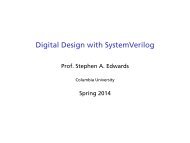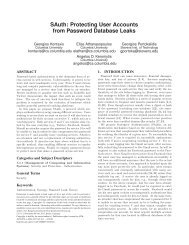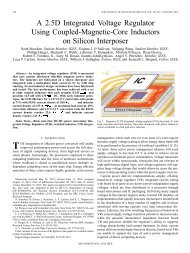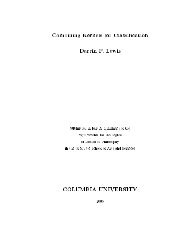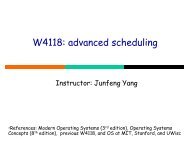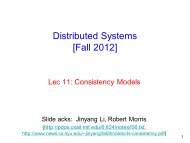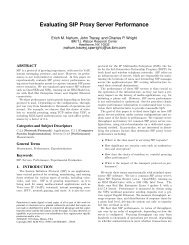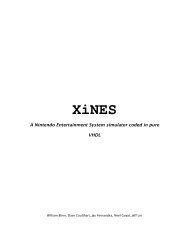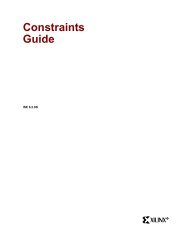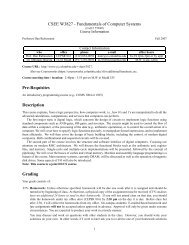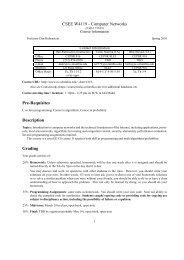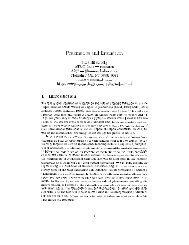e-NeXSh - Columbia University
e-NeXSh - Columbia University
e-NeXSh - Columbia University
Create successful ePaper yourself
Turn your PDF publications into a flip-book with our unique Google optimized e-Paper software.
e-<strong>NeXSh</strong>: Achieving an Effectively Non-Executable Stack and Heap via<br />
System-Call Policing<br />
Gaurav S. Kc<br />
Google, Inc.<br />
gskc@google.com<br />
Abstract<br />
We present e-<strong>NeXSh</strong>, a novel security approach that<br />
utilises kernel and LIBC support for efficiently defending<br />
systems against process-subversion attacks. Such attacks<br />
exploit vulnerabilities in software to override its program<br />
control-flow and consequently invoke system calls, causing<br />
out-of-process damage. Our technique defeats such attacks<br />
by monitoring all LIBC function and system-call invocations,<br />
and validating them against process-specific information<br />
that strictly prescribes the permissible behaviour<br />
for the program (unlike general sandboxing techniques that<br />
require manually maintained, explicit policies, we use the<br />
program code itself as a guideline for an implicit policy).<br />
Any deviation from this behaviour is considered malicious,<br />
and we halt the attack, limiting its damage to within the<br />
subverted process.<br />
We implemented e-<strong>NeXSh</strong> as a set of modifications to the<br />
linux-2.4.18-3 kernel and a new user-space shared<br />
library (e-<strong>NeXSh</strong>.so). The technique is transparent, requiring<br />
no modifications to existing libraries or applications.<br />
e-<strong>NeXSh</strong> was able to successfully defeat both codeinjection<br />
and libc-based attacks in our effectiveness tests.<br />
The technique is simple and lightweight, demonstrating no<br />
measurable overhead for select UNIX utilities, and a negligible<br />
1.55% performance impact on the Apache web server.<br />
1 Introduction<br />
In recent years, the issue of process-subversion attacks<br />
has become very important, as is evidenced by the number<br />
of CERT advisories [2]. These are attacks that exploit programming<br />
errors in software to compromise running systems.<br />
Such errors allow the attacker to override the program’s<br />
control logic, causing the program to execute code<br />
of their choosing. This code is either malicious executable<br />
¡ This work was carried out while author was at <strong>Columbia</strong> <strong>University</strong>.<br />
Angelos D. Keromytis<br />
<strong>Columbia</strong> <strong>University</strong><br />
angelos@cs.columbia.edu<br />
code that has been injected into the process’ memory, or<br />
existing functions in the Standard C library (LIBC) or elsewhere<br />
in the program code. In either case, the attacker is<br />
able to compromise the process, and generally can gain control<br />
of the whole system if the attacked process was running<br />
with root privileges (this is often the case with server daemons).<br />
To cause any real damage outside of the compromised<br />
process, e.g., to spawn a shell or to open the<br />
/etc/passwd file for editing, the attacker needs to access<br />
kernel resources via system calls. There has been significant<br />
research in recent years resulting in a wide range of<br />
process-sandboxing techniques that monitor applications’<br />
system-call invocations [27, 31, 32, 33, 48, 49, 50, 58].<br />
These systems generally require manual effort to specify<br />
explicit sandboxing policies, except when such policies can<br />
be automatically generated from application code or training<br />
runs. Then, the policies are often either imprecise, producing<br />
a large number of false positives, or involve significant<br />
( ¢ 2£ ) overheads — these are described in more detail<br />
in ¤ 5. Other techniques prevent the execution of code<br />
in data memory [3, 5, 10, 13, 38, 40, 55] to defeat codeinjection<br />
attacks, randomise the addresses of functions in<br />
the Standard C library (LIBC) [3, 14, 20] to deter libcbased<br />
attacks, use static analyses to remove vulnerabilities<br />
from software [12, 19, 21, 35, 44, 46, 59], or instrument application<br />
code to detect run-time attacks [22, 47, 28, 57].<br />
There exist problems and/or limitations of these systems<br />
too, including large overheads or breaking of applications,<br />
the possibility of mimicry or brute-force attacks that can<br />
bypass the defence mechanisms, and the inability to specify<br />
or protect all vulnerabilities, respectively. These limitations<br />
are also covered in ¤ 5.<br />
In this paper we present e-<strong>NeXSh</strong>, a simple and<br />
lightweight technique that uses process-specific information<br />
— this information consists of disassembly data indicating<br />
the memory boundaries of all functions in the program,<br />
as well as the call sites for system-call invocations<br />
in the program code — to defeat both code-injection and<br />
libc-based attacks. The technique’s novelty lies in how it
uilds on the system-call interception model used by Intrusion<br />
Detection Systems (IDS), and extends the idea to userspace<br />
code to monitor invocations of LIBC functions. We<br />
utilise the program code and its disassembly information<br />
as guidelines for an implicit policy to prescribe normal program<br />
behaviour, rather than manually defining explicit policies.<br />
We show that e-<strong>NeXSh</strong> creates an “effectively” nonexecutable<br />
stack and heap that permit the execution of all<br />
code except system-call invocations (even via LIBC functions).<br />
This makes our technique practical even for applications<br />
that have a genuine need for an executable stack. We<br />
have evaluated a prototype implementation of our technique<br />
on x86/Linux, and have demonstrated efficacy at defeating<br />
both libc-based and code-injection attacks, including 100%<br />
effectiveness against Wilander’s benchmark test-suite [64],<br />
in our evaluations. We provide further discussion in ¤ 5.<br />
Our implementation consists of two parts: a user-space<br />
component to intercept and validate LIBC function invocations,<br />
and a kernel component to do the same for system-call<br />
invocations. The user-space component (implemented as<br />
a shared library: e-<strong>NeXSh</strong>.so) intercepts invocations of<br />
LIBC functions, and validates the call chain against the program’s<br />
binary code and its disassembly information. This<br />
component can detect libc-based attacks that redirect the<br />
targeted program’s control-flow into LIBC functions, to indirectly<br />
issue system calls. If an invocation has a legitimate<br />
call chain (i.e., one that matches the program code<br />
and disassembly data), we indicate this to the kernel component,<br />
and then forward the call on to the appropriate function<br />
in LIBC. Our kernel component extends the system-call<br />
handler in the Linux kernel to intercept and verify that all<br />
system-call invocations are made from legitimate locations<br />
in the program (or LIBC) code. These components collectively<br />
block all paths that an attacker may take to invoke<br />
system calls.<br />
An important advantage of our technique is the low overhead<br />
added to system execution — we report negligible<br />
run-time overheads for both Apache benchmarks and common<br />
UNIX utilities. By implementing our technique within<br />
LIBC and kernel call handlers, we have managed to capitalise<br />
on the relatively large execution time required to<br />
process most system calls (including time spent in LIBC),<br />
versus normal procedure calls. Our design also permits<br />
transparent integration with applications, without needing<br />
to modify either source or binary code for both applications<br />
and the Standard C library (LIBC). This has many advantages<br />
— for instance, our technique can be applied to<br />
legacy and third-party applications for which there is no access<br />
to the source code. Furthermore, e-<strong>NeXSh</strong> can be used<br />
in conjunction with other defence mechanisms that instrument<br />
application executables or library binaries to perform<br />
run-time checking. Even though we modify the kernel in<br />
our implementation, we can selectively enforce the protection<br />
mechanism, allowing most programs [that do not need<br />
the security] to run unaffected.<br />
The rest of this paper is structured as follows: we present<br />
an overview of our approach in ¤ 2. We describe our implementation<br />
of e-<strong>NeXSh</strong> in ¤ 3, and present an evaluation of<br />
our technique in ¤ 4. We discuss related work in ¤ 5, and<br />
some remaining issues in ¤ 6, and conclude in ¤ 7.<br />
2 Approach<br />
Published guidelines [4, 6, 9] and analyses [7, 15, 23, 24]<br />
of process-subversion attacks indicate that these attacks<br />
generally contain the following integral elements: the triggering<br />
of some security vulnerability in the target application,<br />
causing an overwrite of some code pointer memory<br />
location, making it point to malicious code of the attacker’s<br />
choosing. These elements comprise the anatomy of attacks,<br />
and is illustrated in figure 1. Then, as the program continues<br />
execution, it eventually activates this overwritten code<br />
pointer, and begins executing the attack code in question.<br />
Initiate<br />
Attack<br />
Trigger<br />
Vulnerability<br />
Overwrite<br />
Code-pointer<br />
Execute<br />
Malcode<br />
Figure 1. Anatomy of an Attack.<br />
Invoke<br />
System Call<br />
Research efforts have resulted in tools for identifying<br />
and/or eliminating vulnerabilities from application code, as<br />
well as at run-time techniques for detecting that vulnerabilities<br />
may have been exploited or that certain code pointer<br />
may have been overwritten. Rather than monitor all exploitable<br />
vulnerabilities and over-writable code pointers, we<br />
focus on the third element of attacks, i.e., the malicious code<br />
that attackers execute. Our technique is then able to defeat<br />
both known and yet unknown attacks, regardless of<br />
the specific vulnerabilities they exploit, or the specific code<br />
pointers they overwrite.<br />
The executed malcode is invariably either executable<br />
code that the attacker has injected into the program memory,<br />
or existing code in the program or its referenced libraries,<br />
and in all cases, is executed to invoke some system<br />
call(s). Recognising this fact, we have based our technique<br />
on the monitoring of system-call invocations both within<br />
the kernel and at the user-space levels. We can trivially<br />
identify direct invocations of system calls by injected code,<br />
from within the kernel. Furthermore, we monitor calls to<br />
LIBC functions to detect if existing code in the program or<br />
its libraries is executed to indirectly invoke a system call<br />
(this generally is by way of the appropriate LIBC function).<br />
Specifically, we intercept calls to LIBC functions<br />
at the user-space level to inspect and validate the program
stack. By intercepting both paths to invoking system calls,<br />
we can detect when a compromised program attempts to invoke<br />
system calls. We also randomise the program memory<br />
layout to prevent mimicry attacks would otherwise replicate<br />
the program stack in order to present a seemingly valid call<br />
stack to our checking subsystem.<br />
Table 1 provides a high-level overview of the evolution<br />
of e-<strong>NeXSh</strong> in response to increasingly sophisticated and<br />
adaptive attack mechanisms:<br />
Code-Injection<br />
attacks<br />
(LIBC-based)<br />
Existing-Code<br />
attacks<br />
(Stack-faking)<br />
Mimicry<br />
attacks<br />
Attacks mechanisms and Defence measures<br />
Attack executable attack code injected into data<br />
memory invokes system calls directly.<br />
Defence the kernel component of e-<strong>NeXSh</strong> examines<br />
the “return address” for system calls<br />
to identify code-injection attacks.<br />
Attack attacker invokes system calls indirectly<br />
by redirecting program flow-of-control to<br />
existing trap instruction in either application<br />
or library code, e.g., LIBC. This<br />
avoids the first-level defence against codeinjection<br />
attacks.<br />
Defence the LIBC component of e-<strong>NeXSh</strong> intercepts<br />
invocations of shared library calls,<br />
and verifies the program stack trace (main<br />
— to library function), and thus detects<br />
existing-code attacks.<br />
Attack attacker re-creates signature for a valid<br />
program stack-trace to give e-<strong>NeXSh</strong> the<br />
impression of a normal program run.<br />
Defence randomise the program memory layout<br />
(activation record headers return address,<br />
old frame pointer¡ , offset of program data<br />
stack, and offset of program code segment)<br />
to prevent attackers from re-creating a valid<br />
stack-trace signature.<br />
Table 1. High-level overview of defence tactics in<br />
e-<strong>NeXSh</strong> and possible countermeasures. Each attack<br />
mechanism is a countermeasure to the immediately<br />
preceding defence technique.<br />
3 Implementation<br />
In this section, we describe the two components of our<br />
e-<strong>NeXSh</strong> implementation for the Linux operating system<br />
running on x86 hardware. We then illustrate its operations,<br />
i.e., the sequence of events, for handling both normal program<br />
behaviour and attacks in progress. We end this section<br />
by enumerating some benefits of our technique.<br />
3.1 Validating System-Call Invocations<br />
We use the system calls emitted by a program as an indication<br />
of its behaviour, similar to traditional host-based<br />
intrusion detection systems (IDS) that infer program behaviour<br />
from audit patterns, i.e., the observed sequence of<br />
system calls emitted [34, 42, 43, 58, 65] by the running<br />
program. While these systems generally use source codebased<br />
static models to determine malicious activity, we use<br />
specific information associated with system-call and LIBC<br />
invocations. The novelty in our technique is that we extend<br />
the checking “deeper” into the application’s call stacks,<br />
thus making it more difficult for an attacker to launch<br />
mimicry [60] (or libc-based) attacks.<br />
We chose a kernel-based, system-call interposition technique<br />
to utilise the resource-manager role of the operating<br />
system kernel for monitoring the invocations of system<br />
calls. Similar to normal function-calling conventions in user<br />
code, a system-call invocation also stores information (the<br />
program counter value) about the caller code in the program<br />
stack. We extended the system-call handling utility<br />
in the kernel to verify that it was legitimate application (or<br />
library) code that made the system-call invocation. Specifically,<br />
we check to see that the virtual memory address of<br />
the trap machine instruction that issued the system call is<br />
located in one of the code segments for the process. The<br />
kernel maintains information on all the different code and<br />
data segments that comprise each process’ run-time memory.<br />
Our kernel modifications simply checks the read-write<br />
flag for the given memory address. A “writable” flag denotes<br />
data memory, which we now assume contains injected<br />
code that’s invoking a system call. On the other hand, legitimate<br />
invocations of system calls occur from non-writable<br />
code memory addresses that are associated with a “readonly”<br />
flag.<br />
3.2 Validating LIBC Function Invocations<br />
We extend this caller-validation idea into the user-space<br />
to validate invocations of LIBC functions. This is implemented<br />
in the form of a shared library (e-<strong>NeXSh</strong>.so)<br />
containing corresponding wrapper functions for each LIBC<br />
function that is intercepted — we currently provide wrappers<br />
only for functions that are useful to an attacker [65]<br />
(some of these functions are: chmod, connect, execve,<br />
fork, open, mmap, mprotect, socket). We set the<br />
LD PRELOAD environment variable to ensure that LIBC<br />
function invocations made by programs are directed into our<br />
shared library. Each wrapper function consists of the following<br />
steps: authorise LIBC-based system calls, validate<br />
the current call stack, and resume execution by invoking the<br />
intended LIBC function, or kill the process if authorisation<br />
fails. We describe the most complex step (call-stack validation)<br />
first.
.text<br />
0x0AA0 main:<br />
. . .<br />
0x0AAF<br />
call foo ( 0x0BB0 )<br />
. . .<br />
0x0BB0 foo:<br />
. . .<br />
0x0BBF<br />
call bar ( 0x0CC0 )<br />
. . .<br />
0x0CC0 bar:<br />
. . .<br />
0x0CCF<br />
call execve<br />
. . .<br />
.stack<br />
parameter_a<br />
parameter_b<br />
parameter_c<br />
retAddr( 0x0AAF )<br />
old-frame-ptr<br />
parameter_a<br />
parameter_b<br />
parameter_c<br />
retAddr( 0x0BBF )<br />
old-frame-ptr<br />
foo<br />
bar<br />
Figure 2. The stack trace yields bar’s return address<br />
as 0x0BBF. We de-reference this memory address<br />
(we can verify that it is contained within foo),<br />
and inspect the preceding call instruction to extract<br />
its operand. This operand is 0x0CC0, which we then<br />
verify to match bar’s starting address. In this manner,<br />
given the return address for the stack frame for<br />
“foo calls bar”, we can use the machine code (from<br />
the .text section) to verify that the caller-callee relationship<br />
is legitimate. We repeat these checks for<br />
each return address in the stack trace until we reach<br />
main().<br />
3.2.1 Validating the Call Stack<br />
Each wrapper function performs a stack walk along the<br />
dynamic chain of intermediate functions starting from<br />
main() and ending with the function that eventually invoked<br />
the LIBC function. This yields a list of return address<br />
values for each of the intermediate functions: we first<br />
verify that each of these return addresses exists in the writeprotected<br />
memory region reserved for the application code,<br />
viz., the .text section (we assume that information about<br />
the range of the .text section for the program code is provided<br />
by the kernel). We then inspect the .text section<br />
of the process memory to extract and decode each call<br />
instruction preceding the instructions at these return addresses.<br />
We can now verify that the absolute target address<br />
of this direct call instruction exactly corresponds to the<br />
beginning address of the function that is one level deeper<br />
in the call chain. In other words, for each caller-callee pair<br />
in the dynamic chain, we can validate the call site and target<br />
site memory addresses against the start and end limits<br />
for both functions. Our technique for validating the call<br />
stack is similar to stack-tracing techniques in [26] and those<br />
in Java for checking access control [61], but without the<br />
benefit of Java’s extensive run-time information. Figure 2<br />
illustrates the verification of a single caller-callee function<br />
relationship, where foo calls bar.<br />
The x86 architecture defines other (indirect) call instructions<br />
that are of variable length, and do not encode the<br />
true target of the call instructions. Instead, they utilise<br />
indirect addresses stored in registers or the memory at runtime.<br />
This prevents us from statically producing call graphs<br />
to define all possible caller-callee relationships, and forces<br />
us to accept any function as a potentially valid target for an<br />
indirect call instruction. An attacker could then potentially<br />
overwrite a function pointer variable or a C++ VPTR<br />
entry, and cause a redirection of control directly into a LIBC<br />
function.<br />
There are a number of options available at this point: we<br />
can counter such attacks by requiring the innermost callercallee<br />
pair in the dynamic chain (where the application program<br />
invokes the LIBC function) to be a direct call instruction<br />
— this has the potential to falsely label some applications<br />
as being compromised if they invoke the protected<br />
LIBC functions via function pointers (the applications<br />
we have evaluated do not use indirect call instructions<br />
to invoke LIBC functions). Another approach is to run the<br />
program in training mode and log the occurrences of code<br />
pointers in the call stack. Assuming that these invocations<br />
did not already lead to a process compromise during the<br />
training stage, the logged data can be integrated into the disassembly<br />
information for the program. This allows future<br />
occurrences of these code pointers to be accepted. A third<br />
option is to use a simple static-analysis [11] engine to precompute<br />
sets of acceptable values for the target address for<br />
indirect calls. Correctly using this new information would<br />
increase the memory footprint of e-<strong>NeXSh</strong>.so. However,<br />
the run-time overheads should be minimal since this data is<br />
referenced only for call-stack instances that include indirect<br />
calls. Even so, there may potentially be an efficient means<br />
to further reduce these overheads.<br />
3.2.2 Authorising System Calls<br />
Before validating the call stack, the wrapper function<br />
invokes a new system call that we defined as<br />
syscall libc auth. This system call is used to<br />
indicate to the kernel that the checking mechanism in<br />
e-<strong>NeXSh</strong>.so has verified the user-space section of the call<br />
stack for upcoming system calls. We store a random 1 32-bit<br />
nonce in the stack frame, and pass the address of this nonce<br />
in the system call. This ephemeral nonce value exists only<br />
for the duration of the execution of the wrapper functions<br />
in e-<strong>NeXSh</strong>.so (it is erased before the wrapper function<br />
returns; see below), meaning that it is never available in<br />
1 The 64-bit result from the rdtsc machine instruction indicates the<br />
value of the clock-cycle counter since the machine’s last boot-up. The<br />
least-significant 32 bits of this result provide sufficient randomness for our<br />
purposes.
memory whenever any attacker code may be executing. We<br />
can thus prevent information leakage in a manner similar to<br />
Karger [36] for cross-domain calls, and hence prevent replay<br />
attacks that read and re-use nonces.<br />
The kernel code for syscall libc auth verifies that<br />
this system-call invocation’s call site is in the code section<br />
of e-<strong>NeXSh</strong>.so, and then stores the address and value (by<br />
dereferencing the location on the user-space stack) of the<br />
nonce in the process’ PCB, and returns control to the userspace.<br />
Later on, when verifying system calls invoked via<br />
LIBC functions, the kernel checks to make sure that the<br />
nonce that was specified most recently still exists at the<br />
given location (the nonce location becomes invalid when we<br />
obliterate the nonce value from the stack, see next). Note<br />
that by setting the nonce before validating the call stack,<br />
we are able to prevent attacks that might otherwise jump<br />
into the middle of our wrapper functions to skip the initial<br />
checks.<br />
After issuing the authorisation system call and validating<br />
the call stack, the wrapper function resumes the program<br />
execution by passing control to the original LIBC function<br />
(referenced via explicit dlopen / dlsym calls) which may,<br />
in turn, invoke system calls. These system calls are accepted<br />
by the kernel since not only are they invoked by a<br />
trap instruction located in the code section (of LIBC), but<br />
also because the nonce value that was passed to the kernel<br />
is still valid. When the LIBC function completes execution,<br />
it will return control to our wrapper function. We now zero<br />
out the nonce value on the stack (to eliminate the possibility<br />
of any mimicry attack re-using the nonce), and return to<br />
the application. We reduced the overhead from an earlier<br />
implementation that involved a separate system call to indicate<br />
to the kernel that the current e-<strong>NeXSh</strong>.so wrapper<br />
had completed its execution, and was returning control to<br />
the application.<br />
Multi-threaded applications may enable attackers to use<br />
a parallel thread to invoke malicious system calls (this<br />
thread would still need to use a libc-based attack to avoid<br />
issuing a system call directly from data memory) after getting<br />
a legitimate program thread to carry out the systemcall<br />
authorisation. We counter this threat by implementing<br />
semaphore-based synchronisation in the e-<strong>NeXSh</strong>.so<br />
wrapper functions to ensure that multiple threads are not<br />
concurrently allowed into the critical LIBC (and subsequent<br />
system-call) functions. This could potentially cause synchronisation<br />
problems with system calls that block on I/O,<br />
e.g., read on a socket interface. However, none of the<br />
LIBC functions we currently protect are blocking functions.<br />
3.2.3 Attacks Against e-<strong>NeXSh</strong><br />
An attacker could attempt a direct target at the e-<strong>NeXSh</strong><br />
protection mechanism by overwriting the program stack to<br />
make it appear as a valid run for the given program. This<br />
allows the attacker to issue any system call that the application<br />
could invoke during normal execution. The difference<br />
is, of course, in the system-call parameter being provided:<br />
an attacker could exploit this loophole to access critical files<br />
by compromising any program that does file I/O. This problem<br />
is similar to that of attackers overwriting critical program<br />
data that are used as parameters for system calls, and<br />
a general solution is to manually define policies [49] to dictate<br />
the set of file-system resources that each program can<br />
access, for instance.<br />
This loophole in e-<strong>NeXSh</strong> allows an attacker to create<br />
a fake, but seemingly valid, stack, and consequently pass<br />
both the LIBC- and kernel-based checks. Such attacks<br />
have been demonstrated in [17] to mimic a valid program<br />
stack, allowing them to successfully bypass commercialgrade<br />
sandboxing products and consequently invoke system<br />
calls. Later, we describe how we can counter these attacks<br />
by using simple randomisation techniques to make it significantly<br />
harder for an attacker to re-create a valid stack.<br />
Kruegel et al. [41] describe a binary code-analysis<br />
method involving symbolic execution [39] of victim programs,<br />
to construct attacks that can automatically regain<br />
program control even after issuing system calls (possibly<br />
by using faked stacks). These are mimicry attacks of a different<br />
kind [41, 60] in that they intend to invoke a number of<br />
system calls matching a valid audit trail for the given program,<br />
enabling them to evade detection by traditional hostbased<br />
IDS systems [34, 42, 43, 58, 65] that may be monitoring<br />
such program audit trails. Kruegel’s attacks use faked<br />
stack traces to thwart Feng’s [27] and Sekar’s [53] stackverification<br />
techniques, and then repeatedly regain program<br />
control, allowing them to defeat the defence techniques’<br />
audit-trail monitoring mechanisms. In this manner, Kruegel<br />
has reduced the task of breaking techniques such as [27, 53]<br />
into a matter of invoking system calls a number of times.<br />
A critical requirement for Kruegel’s generated attacks to<br />
successfully regain program control after a system-call invocation<br />
is their need to maliciously modify code pointers,<br />
specifically, entries in the Procedure Linkage Table (PLT) 2 .<br />
In this regard, we can trivially render Kruegel’s method ineffective<br />
by extending e-<strong>NeXSh</strong>.so’s initialisation (when<br />
the program is loaded) to carry out eager evaluation of the<br />
program’s PLT, and subsequently write-protecting the PLT<br />
to prevent any updates. Preventing the attack from updating<br />
these code pointers has the effect that it eliminates the possibility<br />
of Kruegel’s attacks regaining program control after<br />
attempting a system-call invocation. However, even this<br />
may be redundant given the increased difficulty in creating a<br />
fake stack that can evade e-<strong>NeXSh</strong>.so, as described next.<br />
The core elements of creating a fake stack are: determine<br />
what memory locations in the stack should contain the<br />
2 Kruegel states that other code pointers, e.g., function pointers, do not<br />
reliably produce a successful exploit
eturn address and old frame-pointer values for activation<br />
records, and overwrite these locations with values that are<br />
valid for a normal program run. We employ randomisation<br />
on different portions of the process memory layout to make<br />
it hard to fake the stack. We first offset the starting location<br />
of the program stack by a random 16-bit value as in [14], increasing<br />
the difficulty for an attacker in figuring out which<br />
memory addresses on the stack to overwrite. We can also<br />
use either a suitably modified compiler [22, 37] or binaryediting<br />
tool [47] to obfuscate (using 32-bit XOR keys) the<br />
stored values in the stack-frame headers for the return address<br />
and old frame-pointer value. Note that the XOR keys<br />
need to be communicated to and stored in e-<strong>NeXSh</strong>.so to<br />
reconstruct the original return address and old frame-pointer<br />
values when traversing and validating the stack — the location<br />
where these values are stored can be randomised,<br />
and protected against scanning attacks by storing between<br />
unmapped memory pages (an attacker trying to read from<br />
these pages will cause a memory protection violation, and<br />
thus crash the process).<br />
Obfuscating the stored return address and old-frame<br />
pointer values significantly increases the difficulty for an<br />
attacker in determining what values to write on the stack<br />
frames to simulate a valid stack. Even if he does figure out<br />
which locations on the stack to overwrite, he would need to<br />
know the XOR values for both the return address and old<br />
frame-pointer. Finally, we also randomise the starting offset<br />
(as in [14]) for the .text segment by a random 24-bit<br />
value, thus randomising function addresses in the program<br />
code. This further increases the difficulty for an attacker<br />
to figure out what values (for function return addresses) to<br />
write on the program stack to mimic a valid stack.<br />
These are standard compile-time or program load-time<br />
techniques for obfuscating the program’s stack segment and<br />
code segment layout, and can be implemented for no additional<br />
run-time cost while still increasing the work-load<br />
for a brute-force attack by a factor of up to ¢¡¤£<br />
¥<br />
(16 + 32<br />
+ 32 + 24). Combining e-<strong>NeXSh</strong>’s system-call and LIBC<br />
function-call monitoring with these obfuscation techniques<br />
addresses their mutual shortcomings, and makes for a more<br />
powerful defence system than with either technique in isolation.<br />
For instance, a program protected solely by these<br />
obfuscation techniques, i.e., in the absence of our call monitoring,<br />
can trivially be defeated by an attacker simply injecting<br />
and executing code in data memory, or overwriting<br />
a program code pointer to invoke a LIBC function — this is<br />
demonstrated by brute-forcing attack techniques as reported<br />
in Shacham [54]. Conversely, e-<strong>NeXSh</strong>’s call monitoring<br />
techniques are susceptible to stack-faking attacks in the absence<br />
of such obfuscations.<br />
3.3 Operation<br />
We now describe the normal invocation of LIBC functions<br />
by application code and a libc-based attack scenario.<br />
A code-injection attack that issues system calls directly<br />
from data memory will obviously be detected by our kernel<br />
code. By defining the LD PRELOAD environment variable,<br />
the program’s invocations of LIBC functions are directed<br />
into the appropriate wrapper function in e-<strong>NeXSh</strong>.so<br />
which issues the authorising system call, validates the program<br />
call stack, and invokes the intended LIBC function, in<br />
order. On the other hand, a standard libc-based attack will<br />
generally transfer control directly into the original LIBC<br />
function. Consequently, when this function issues system<br />
call(s), our kernel component will correctly reject them due<br />
to the lack of authorisation (i.e., the last specified nonce<br />
location has been invalid since the last invocation of any<br />
e-<strong>NeXSh</strong>.so wrapper function). A more sophisticated<br />
libc-based attack that inspects the entries in the Procedure<br />
Linkage Table (PLT) or Global Offset Table (GOT) can invoke<br />
the relevant wrapper function in our shared library.<br />
However, the call stack-validation code will detect the deviation<br />
from the program’s normal behaviour, and can log the<br />
attack attempt and halt the process by issuing a SIGKILL<br />
signal. Directly issuing system calls for both logging and<br />
signaling and also not returning control to the application<br />
makes our technique invulnerable to extended attacks, e.g.,<br />
[16, 41], that may have compromised the logging- or exithandler<br />
code as a means of regaining control.<br />
Figure 3 illustrates a successful, legitimate invocation of<br />
the sys execve system call by function foo in the application<br />
code, as well as an unsuccessful attempt by the<br />
malicious code shellcode to invoke functions in LIBC.<br />
As a result, malicious code can invoke system calls neither<br />
directly nor indirectly via LIBC functions.<br />
3.4 Transparency of Use<br />
Our implementation imposes no interference on normal<br />
system operations. Firstly, we can enforce protection on<br />
only those programs that need security, e.g., server daemons<br />
like httpd, sendmail, smbd, imapd, and leave<br />
the rest of the system unaffected. The user-space component<br />
e-<strong>NeXSh</strong>.so can be disabled by simply not setting<br />
the LD PRELOAD environment variable. We created<br />
a flag in the kernel’s Process Control Block (PCB) data<br />
structure that has to be set in order for our kernel component<br />
to validate system-call invocations. This flag can<br />
be set by a variety of means in the kernel’s process loading<br />
code: (a) the LD PRELOAD environment variable is set<br />
(and contains e-<strong>NeXSh</strong>.so), (b) the program’s name contains<br />
the prefix enxProtect , or (c) the program image<br />
contains an ELF [56] section titled enexsh, consisting of<br />
pre-computed disassembly information for the program and<br />
the referenced libraries.
c<br />
1 #include <br />
2<br />
3 char *shellcode =<br />
4 "\xeb\x1f\x5e\x89\x76\x08\x31\xc0"<br />
5 "\x88\x46\x07\x89\x46\x0c\xb0\x0b"<br />
6 "\x89\xf3\x8d\x4e\x08\x8d\x56\x0c"<br />
7 "\xcd\x80\x31\xdb\x89\xd8\x40\xcd"<br />
8 "\x80\xe8\xdc\xff\xff\xff/bin/sh";<br />
9<br />
10 int main(void) {<br />
11 char buffer[96];<br />
12 int i = 0, *p = (int *) buffer;<br />
13 while (i++ < 32) *p++ = (int) buffer;<br />
14 strncpy (buffer, shellcode,<br />
15 strlen (shellcode));<br />
16 return 0;<br />
17 }<br />
a<br />
x<br />
Figure 4. Sample stacksmashing attack.<br />
User-space<br />
foo:<br />
. . .<br />
call execve<br />
e-<strong>NeXSh</strong>.so<br />
execve:<br />
syscall_libc_auth<br />
// validate call stack<br />
call libc.execve<br />
// delete nonce<br />
execve:<br />
. . .<br />
movl 0xb, %ebx<br />
int $0x80<br />
shellcode:<br />
. . .<br />
call execve<br />
libc.so<br />
b<br />
d<br />
Kernel<br />
syscall:<br />
e<br />
// check protection flag<br />
// validate caller addr in .text<br />
// verify nonce<br />
call syscall_table[i]<br />
Syscall Table<br />
sys_fork<br />
sys_execve<br />
sys_execve:<br />
. . .<br />
sys_fork:<br />
. . .<br />
Figure 3. The sequence (abcdef) indicates a successful<br />
system-call invocation by “valid” function foo,<br />
being routed through the new execve wrapper function<br />
in e-<strong>NeXSh</strong>.so and the original LIBC wrapper<br />
function execve, in order. Step (b) represents the<br />
operations of the new wrapper function, starting with<br />
it informing the kernel to authorise the invocation of<br />
sys execve, and ending with the stack trace and<br />
caller-callee verifications, just before before calling<br />
the original LIBC function. Step (d) signifies the execution<br />
of the trap instruction, and the triggering of<br />
the system-call signal handler in the kernel, and step<br />
(e) represents the kernel performing its own checks,<br />
verifying that the calling code’s virtual memory address<br />
is in read-only memory, and that the currently<br />
requested system call is authorised (by checking the<br />
nonce). The sequence (xde) indicates an unsuccessful<br />
attempt by attack code in shellcode to invoke the<br />
same system call via LIBC. The attack fails the nonce<br />
check at step (e), because the system-call invocation<br />
has not been authorised.<br />
f<br />
Our technique allows for code execution on the stack<br />
and heap as long as it does not invoke a system call or<br />
LIBC function. A benefit of this feature is that e-<strong>NeXSh</strong><br />
does not break applications with a genuine need for an executable<br />
stack, e.g., LISP interpreters. However, by preventing<br />
system-call or LIBC function invocations from the stack<br />
or heap, e-<strong>NeXSh</strong> creates an “effectively” non-executable<br />
stack and heap. This is an improvement over true nonexecutable<br />
stack and heap techniques that either break legitimate<br />
applications, or require significant effort to allow<br />
such code to execute on the stack or heap.<br />
4 Evaluation<br />
In this section, we report on our evaluations of the efficacy<br />
and usability of our technique. We conducted experiments<br />
to measure both its effectiveness in protecting the<br />
system from various attacks, and impact to the system performance.<br />
4.1 Efficacy<br />
The foremost objective of any protection mechanism is<br />
successful defence against attacks. We have used e-<strong>NeXSh</strong><br />
to defeat stack- and heap-based code-injection attacks based<br />
on our modified version of Aleph One’s stacksmashing attack<br />
(figure 4), and an example libc-based attack using<br />
the sample program in figure 5. To further test our technique’s<br />
effectiveness against attacks, we ran a benchmark<br />
test-suite compiled by Wilander and Kamkar [64]. This<br />
code-injection attack test-suite contains 20 different bufferoverflow<br />
techniques to overwrite vulnerable code pointers,<br />
viz., function’s return address, function pointer variables,<br />
old frame pointer, and longjmp buffers, in all of the stack,<br />
heap, .bss and data segments of process memory. e-<br />
<strong>NeXSh</strong> was able to achieve 100% effectiveness by defeating<br />
all 20 attacks, a significant improvement over the mere 50%<br />
achieved by ProPolice [25], the best buffer overflow detector<br />
tool evaluated by Wilander. A dynamic buffer-overflow<br />
detector [51] also managed 100% effectiveness using this<br />
test-suite, however with a considerably larger (upto ¢¡¤£¦¥ )<br />
overhead. We discuss performance issues due to e-<strong>NeXSh</strong><br />
next.<br />
4.2 Usability<br />
The usability issues related to incorporating any security<br />
mechanism are manifold, including impact on system<br />
performance, increase in program disk or memory usage,<br />
any other interference with normal system operation (e.g.,<br />
breaking certain applications), and ease of incorporating the
normalised execution time<br />
8<br />
7<br />
6<br />
5<br />
4<br />
3<br />
2<br />
1<br />
0<br />
Micro-benchmark: system calls<br />
mmap fork open mprotect getpid brk connect socket<br />
system calls<br />
none enx-disabled enx-enabled<br />
Figure 6. e-<strong>NeXSh</strong> micro-benchmark: System calls.<br />
The three columns indicate mean execution time for<br />
each system call on: (a) a stock Linux system, (b) an<br />
e-<strong>NeXSh</strong>-enhanced Linux system, but without applying<br />
either kernel or LIBC protection, and (c) full e-<br />
<strong>NeXSh</strong> protection. The values are normalised to column<br />
(a), i.e., the mean execution time for stock Linux.<br />
Requests per second<br />
15000<br />
14000<br />
13000<br />
12000<br />
11000<br />
10000<br />
9000<br />
8000<br />
7000<br />
6000<br />
5000<br />
4000<br />
3000<br />
2000<br />
1000<br />
0<br />
Apache Macro-benchmarks: ApacheBench<br />
14796.128 14663.876 14566.668<br />
Average number of iterations<br />
Apache Apache with e-<strong>NeXSh</strong> disabled Apache with e-<strong>NeXSh</strong> enabled<br />
Figure 7. e-<strong>NeXSh</strong> macro-benchmark:<br />
ApacheBench. The height of each column indicates<br />
the number of requests that Apache could<br />
process each second.<br />
1 #include <br />
2<br />
3 char *argv[] = { "/bin/sh" };<br />
4 int main(void) {<br />
5 void **fp = (void **) &fp;<br />
6 fp[2] = execve;<br />
7 fp[4] = argv[0];<br />
8 fp[5] = argv;<br />
9 fp[6] = 0;<br />
10 return 0;<br />
11 }<br />
Figure 5. Sample libc-based attack.<br />
technique (e.g., any manual effort required). We focus primarily<br />
on the impact to system performance due to our in-<br />
terception of LIBC function and system-call invocations.<br />
4.2.1 Execution Overheads<br />
We ran a set of micro-benchmarks to determine the<br />
worst-case performance hit on system-call invocations (via<br />
LIBC), and macro-benchmarks to determine the performance<br />
impact on real-world software. We used the<br />
ApacheBench benchmarking tool from the Apache HTTP<br />
Server project [1] and several common UNIX tools for the<br />
macro-benchmarks. Our results show that e-<strong>NeXSh</strong> imposes<br />
a small performance overhead on average for Apache-<br />
1.3.23-11 ( 1.5% reduction in request-processing capability),<br />
and tools like tar and gzip. These benchmarks<br />
were compiled with the gcc-3.2 compiler with no debugging,<br />
and no optimisation. The benchmarks were run on a<br />
1.2GHz Pentium III machine with 256MB of RAM. Timing<br />
measurements were made using the gettimeofday function<br />
for the micro-benchmark tests, and the UNIX time<br />
tool for the macro-benchmark tests. ApacheBench provided<br />
its own timing results.<br />
Micro-benchmarks We wrote a C program that uses the<br />
gettimeofday function to measure the system time to<br />
invoke each LIBC function (corresponding to the system<br />
call, see next) LIMIT times in a loop (LIMIT == 10,000).<br />
We then divided the total time by LIMIT to get the mean<br />
execution time per invocation. We collected such values<br />
from 10 runs, and averaged the median 8 values for each<br />
system call. Figure 6 shows the results for individual microbenchmarks<br />
to assess upper-bound performance overhead<br />
for several potentially dangerous system calls (that would<br />
be used by an attacker), a system call (brk) frequently invoked<br />
for dynamic memory allocations, and a lightweight<br />
system call (getpid).<br />
Note the spikes for open, mprotect, connect and<br />
socket system calls, indicating overheads of almost £<br />
We ran additional tests with varying LIMIT (1, 10, 100,<br />
1000, and 10000) for each of these system calls, and discovered<br />
that the e-<strong>NeXSh</strong> overhead per system-call invocation<br />
(the overhead settles in the range 3–8¢¤£ per 2–4¢¤£ systemcall<br />
execution time) became more prominent at higher iterations<br />
— these additional results are tabulated in appendix A.<br />
Macro-benchmarks We chose the ApacheBench benchmarking<br />
suite for the Apache [1] HTTP server project<br />
as a realistic benchmark for evaluating the performance<br />
impact of e-<strong>NeXSh</strong>. Apache is ideal for this<br />
purpose owing to its wide-spread adoption, and to<br />
the fact that it exercises many of the wrapper functions<br />
in e-<strong>NeXSh</strong>.so such as connect, execve,<br />
fork, open, and socket. We ran the ab tool<br />
from ApacheBench with the parameters: -n 10000<br />
¡ .
Normal e-<strong>NeXSh</strong> Overhead<br />
Benchmark in seconds in seconds in percent<br />
ctags 9.98 0.14 9.91 0.10 -0.60 1.93<br />
gzip 10.98 0.62 11.19 0.44 2.09 6.45<br />
scp 6.30 0.04 6.29 0.04 -0.15 0.96<br />
tar 12.89 0.28 13.12 0.46 1.84 3.91<br />
Table 3. e-<strong>NeXSh</strong> macro-benchmark: UNIX utilities,<br />
-C 1000 http://localhost/50KB.bin to simulate<br />
1000 concurrent clients making a total of 10,000 requests<br />
for a 50KB file through the loopback network device<br />
(i.e., on the same host as the web server, to avoid network<br />
latency-induced perturbations to our results). We collected<br />
and averaged the results for 5 runs of ab for each<br />
server configuration (see next). The machine was otherwise<br />
unloaded.<br />
Table 2 shows the results of our macro-benchmark tests<br />
(also plotted in figure 7). The Apache server suffers a small<br />
1.55% decrease (though the standard deviation indicates<br />
that this decrease is insignificant) in request-handling capacity<br />
while running under full e-<strong>NeXSh</strong> protection (column<br />
3, Apache +ENX), as compared to running on a stock<br />
Linux system (column 1, Apache). Column 2 (Apache<br />
-ENX) signifies the Apache server running unprotected<br />
on top of an e-<strong>NeXSh</strong>-enhanced kernel, however with e-<br />
<strong>NeXSh</strong> disabled.<br />
Apache Apache (-ENX) Apache (+ENX)<br />
14796.13 244.96 14663.88 142.90 14566.67 197.86<br />
(decrease in throughput) -0.87% 1.98 -1.55% 2.14<br />
Table 2. e-<strong>NeXSh</strong> macro-benchmark: ApacheBench.<br />
The values in the first data row indicate the number<br />
of HTTP requests handled per second (averaged over<br />
5 runs, and corresponding standard deviation) by the<br />
server in each configuration. The second row shows<br />
the average decrease in throughput in comparison to<br />
Apache running on stock Linux.<br />
We also ran some tests to determine e-<strong>NeXSh</strong>’s impact<br />
on the performance of common, non-server UNIX programs.<br />
Table 3 shows the execution time (averaged over 5<br />
runs, and corresponding standard deviation) for the ctags,<br />
gzip, scp and tar utilities, measured using the UNIX<br />
time command. Three of these tests involved a local<br />
glibc-2.2.5 code repository: we ran ctags to generate<br />
indexes for the GLIBC source code, tar to create<br />
an archive of the source code repository, and scp to upload<br />
the archive file to a remote server (using public keys<br />
for automatic authentication). We also created a 50MB file<br />
by reading bytes from /dev/random, and we compressed<br />
this file using gzip (it compressed the GLIBC archive too<br />
fast for us to get a meaningful time measurement). These<br />
results show that overhead added by e-<strong>NeXSh</strong> to these common<br />
programs is insignificant: in the final column, the reported<br />
overhead is consistently smaller in magnitude than<br />
the standard deviation.<br />
4.2.2 Other Usability Issues<br />
Recall that e-<strong>NeXSh</strong> operates completely transparently to<br />
applications and existing libraries, meaning that their disk<br />
usage remains constant. The run-time memory usage of<br />
protected programs increases by the size of the data structure<br />
representing function boundaries (at 16 bytes per function,<br />
Apache-1.3.23-11 has 790 functions, i.e., increased<br />
memory footprint of 3KB) in e-<strong>NeXSh</strong>.so. If the<br />
e-<strong>NeXSh</strong>.so shared library is customised for each application,<br />
this will increase the disk usage marginally (currently<br />
34KB).<br />
Once the kernel has been patched, and a suitable<br />
e-<strong>NeXSh</strong>.so shared library made available, applying e-<br />
<strong>NeXSh</strong> protection to an application is a simple matter of by<br />
setting the LD PRELOAD environment variable. Unlike the<br />
non-executable stack and heap techniques, e-<strong>NeXSh</strong> does<br />
not break applications that require execution of code on<br />
the stack or heap, or require complex workarounds to “unbreak”<br />
them. Also, extending e-<strong>NeXSh</strong>.so with a new<br />
wrapper is very easy, requiring only a one-line C macro to<br />
define the wrapped LIBC function’s signature.<br />
5 Related Work<br />
Our technique is similar to existing work in three general<br />
areas of security research: (a) system-call interposition<br />
techniques for process sandboxing or intrusion detection,<br />
(b) techniques that prevent the execution of injected code,<br />
and (c) address obfuscation techniques to combat libc-based<br />
attacks. Though there exist certain overlaps in these areas,<br />
we discuss each area separately.<br />
5.1 System-Call Interposition<br />
System-call interception-based intrusion-detection systems<br />
[18, 32, 34, 58, 62, 63] are similar to our technique<br />
in that they passively observe process behaviour. The observed<br />
behaviour of the running program, as signified by<br />
its audit trails, i.e., the sequence of system calls issued by<br />
the running program, is validated against an abstract Finite<br />
State Machine (FSM) model that represents normal execution<br />
of the monitored programs. These model can be constructed<br />
either during a training phase, or it can be generated<br />
from other compile-time information about the program.<br />
Running these systems within acceptable overheads has
generally resulted in loss of precision, yielding a large number<br />
of false positives, and sometimes even false negatives.<br />
Giffin [33], another system call-driven, intrusion-detection<br />
system, is an improvement over Wagner and Dean’s technique<br />
[58] that uses static disassembly techniques on Solaris<br />
executables to create a precise, yet efficient model (based<br />
on the Dyck language) to represent the beginning and end<br />
of function invocations. Feng [27] and Rabek [50] take<br />
the concept of system-call interception a step further by inspecting<br />
return addresses from the call stack to verify them<br />
against the set of valid addresses for the program. This is<br />
similar to our (kernel-level) concept of validating the virtual<br />
memory address of code that issues the trap instruction,<br />
and the validation of the call stack return addresses in<br />
e-<strong>NeXSh</strong>.so. However, these systems incur larger overheads<br />
as they get the kernel to extract and verify individual<br />
return address values from the program call stack, whereas<br />
we only have to validate a single address in the kernel. Instead,<br />
we verify the user-space call stack completely within<br />
our user-space component. Another important advantage of<br />
our system is the simplicity of our technique — instead of<br />
an FSM-based model, we simply use the program code (as<br />
a call-graph model) to validate program call stacks.<br />
Gao’s evaluation [29] concludes that mimicry attacks can<br />
break anomaly-detection techniques that intercept system<br />
calls and analyse audit trails. These mimicry attacks exploit<br />
the fact that such anomaly-detection techniques define<br />
normal program behaviour in terms of audit trails.<br />
Our technique is not similarly vulnerable to these attacks<br />
since we monitor not audit trails over a period of time,<br />
but rather the entire call stack to validate against the static<br />
program code. In ¤ 3.2.3, we discussed the ineffectiveness<br />
against e-<strong>NeXSh</strong> of Kruegel [41], a similar method<br />
for automating mimicry attacks against certain classes of<br />
intrusion-detection systems. A Phrack article [17] presents<br />
a mimicry attack [29, 41] (using faked stack frames) to defeat<br />
two commercial sandboxing products for the Windows<br />
operating system, viz., NAI Entercept and Cisco Security<br />
Agent, that perform kernel-based verification of the return<br />
addresses on the user-space stack and the return address of<br />
the trap call. These defence techniques are tricked into<br />
accepting the faked stack frames since they only check that<br />
the return addresses from the stack-trace exist in a .text<br />
section. Our full caller-callee validation in e-<strong>NeXSh</strong>.so<br />
combined with the stack- and code-segment obfuscations<br />
(¤ 3.2.3) would thwart a Linux version of this attack, given<br />
that we make it much harder to fake the stack.<br />
Linn et al. [45] present a defence technique that is very<br />
similar to e-<strong>NeXSh</strong> is terms of its objectives and methods.<br />
They also use the locations of trap instructions in code<br />
memory to identify illegal invocations of system calls by<br />
code-injection attacks — whereas our kernel module simply<br />
inspects the “return address” of system-call invocations and<br />
checks the memory page’s read/write flag, Linn’s technique<br />
uses the PLTO [52] binary rewriting tool to pre-process executable<br />
files to construct an Interrupt Address Table (IAT)<br />
of valid sites for system calls. The IAT is loaded by the kernel,<br />
and referenced for a matching “return address” entry<br />
when validating each system-call invocation during the program<br />
run. Linn’s technique inherits the PLTO tool’s inability<br />
to handle dynamically linked executables, and hence has<br />
to include all referenced library code, e.g., LIBC, in a single<br />
static executable to deal with the trap instructions in the<br />
LIBC code. e-<strong>NeXSh</strong>, on the other hand, still only needs<br />
to verify that the “return address” of the trap instruction<br />
exists in a write-protected memory area — for LIBC, this<br />
would be the code-segment of libc.so in the program<br />
memory.<br />
Besides their method of monitoring system-call instructions<br />
to identify code-injection attacks, Linn also includes<br />
a mechanism parallel to our e-<strong>NeXSh</strong>.so, i.e., for identifying<br />
attacks that use existing trap instructions in the program<br />
(or library) code to invoke system calls. Linn classifies<br />
these attacks into “known address” and “scanning” categories,<br />
and focuses on using obfuscation techniques to defeat<br />
such “scanning” attacks, including (a) using the PLTO<br />
tool to replace the trap instructions with other machine instructions<br />
that are guaranteed to also cause a kernel trap, (b)<br />
removing from executables any symbolic information that<br />
might aid an attacker in figuring out where the trap instructions<br />
were replaced, (c) interspersing nop-equivalent<br />
instructions in the program code, and (d) interspersing the<br />
address space of the executable with munmap’d memory<br />
pages. This collection of obfuscation techniques serves to<br />
prevent a “scanning” attacker from using an existing trap<br />
location in the program code to invoke system calls. However,<br />
when compared to e-<strong>NeXSh</strong>.so that accomplishes<br />
the same purpose, we see that Linn’s performance overhead<br />
(15%) is approximately £ ¢£ greater than that for e-<strong>NeXSh</strong>.<br />
Linn attributes their large overhead primarily to a degraded<br />
instruction-cache performance, and points out that their layout<br />
randomisation easily leads to a high rate of TLB misses.<br />
Another disadvantage of their technique is the need to modify<br />
the executable files in a highly intrusive fashion, which<br />
is likely to complicate matters for both debugging purposes<br />
and interoperability with other, independent defence techniques.<br />
Some intrusion-detection systems require manual effort<br />
to define and update explicit policies [18, 49] to restrict<br />
programs’ run-time operations. Our technique obviates the<br />
need for such explicit policies: instead, we use the program<br />
code in the .text segment and its disassembly information<br />
as guidelines for an implicit policy.
5.2 Defence Against Code-Injection Attacks<br />
Process-specific randomised instruction sets [13, 38]<br />
and process shepherding [40] have demonstrated resilience<br />
against code-injection attacks by only permitting trusted<br />
code to execute, where the trust is dictated by the origins of<br />
the code. These systems rely heavily on the use of machine<br />
emulators or binary translators incurring large overheads,<br />
and hence are unsuitable for real-world use.<br />
Techniques like [3, 5, 10, 55] protect against codeinjection<br />
attacks by making the program stack, heap and<br />
static data areas non-executable. By default, these data areas<br />
are mapped to memory pages marked writable in the<br />
Linux operating system. Since the 32-bit x86 architecture<br />
only provides support to specify whether individual memory<br />
pages are writable and/or readable, there is no efficient<br />
means of specifying whether a given page is executable.<br />
This has resulted in operating systems like Linux considering<br />
readable pages as also being executable. These nonexecutable<br />
stack and heap techniques [3, 55] have developed<br />
a software solution for distinguishing the readable and<br />
executable capabilities for individual pages, and have been<br />
successful in preventing the execution of code in these areas,<br />
although in a mostly non-portable manner. A critical<br />
drawback of these approaches is that they break code with<br />
legitimate need for an executable stack, prompting the development<br />
of complex workarounds to facilitate such code,<br />
e.g., trampolines for nested functions (a GCC extension to<br />
C) and signal-handler return code for Linux.<br />
Recent processors [30] provide native hardware support<br />
for non-executable pages via a NoExecute (NX) flag.<br />
This, however, will serve only to make redundant the code<br />
used to emulate the per-page execute bit — the complex<br />
workarounds and associated overheads to allow executable<br />
stacks and heaps for applications that require them still remain.<br />
Furthermore, these techniques cover only a subset of<br />
exploitation methods (e.g., existing-code or libc-based attacks<br />
are still possible).<br />
Our approach can also be thought of as making data<br />
memory non-executable for the purposes of injected code<br />
invoking system calls or LIBC functions. However, our<br />
technique does not prohibit the execution of most code that<br />
has been deposited into data memory (the exception is the<br />
trap instruction to make system calls), making it possible<br />
to run applications that require an executable stack.<br />
5.3 Address Obfuscation<br />
Address-obfuscation techniques [3, 14, 20] can disrupt<br />
libc-based attacks by randomising the locations of key system<br />
library code and the absolute locations of all application<br />
code and data, as well as the distances between<br />
different data objects. Several transformations are used,<br />
such as randomising the base addresses of memory regions<br />
(stack, heap, dynamically linked libraries, routines,<br />
and static data), permuting the order of variables and routines,<br />
and introducing random gaps between objects (e.g.,<br />
by randomly padding stack frames or malloc()’d regions).<br />
However, Shacham et al. [54] recently demonstrated<br />
the futility of such address-obfuscation techniques for 32bit<br />
systems (they can only utilise 16 bits of randomness)<br />
by creating an attack to defeat PaX’s address space layout<br />
randomisation in 216 seconds. e-<strong>NeXSh</strong> is not vulnerable to<br />
this attack since we do not obfuscate the memory addresses<br />
of LIBC functions. The secret component in our technique,<br />
i.e., the nonce, is reliably secure against re-use by attackers<br />
since we create and destroy the nonce values entirely<br />
within e-<strong>NeXSh</strong>.so. Furthermore, we employ up to 104<br />
bits (compare to 16bits for the tests in [54]) of randomness,<br />
which greatly increases the difficulty for an attacker.<br />
6 Open Issues and Future Work<br />
An underlying assumption in our work is that an attack<br />
needs to interact with the system outside its compromised<br />
process, and that this interaction can be tightly monitored<br />
and controlled by the OS kernel. Linux allows an<br />
application to carry out memory-mapped I/O without having<br />
to issue system-calls except for one initial call to the<br />
mmap system call. The techniques presented in this paper<br />
cannot detect when a compromised process is performing<br />
memory-mapped I/O. However, such an attack is effective<br />
only against a program that has already set up memorymapped<br />
access to critical files.<br />
e-<strong>NeXSh</strong> is incompatible with systems that involve<br />
copying executable code to data sections for the purposes<br />
of execution — this will immediately be flagged as execution<br />
of injected code, and the process will be halted. For<br />
instance, techniques like LibVerify [12] and Program Shepherding<br />
[40] that require execution of managed or shepherded<br />
code stored in data pages cannot be used in conjunction<br />
with e-<strong>NeXSh</strong>.<br />
One deficiency of our system is that it does not protect<br />
against attacks that exploit vulnerabilities to overwrite crucial<br />
(non-code pointer) data. This could enable the attacker<br />
to bypass application-specific access-control checks, or, in<br />
extreme cases, even be able to specify the parameter for the<br />
program’s own invocation of the system call. However,<br />
few techniques [18, 49] monitor system-call parameters to<br />
protect against such attacks, and only with manually edited,<br />
explicit policies.<br />
6.1 Future Work<br />
Our implementation relies on program and library disassembly<br />
for validating stack traces, and is currently un-
able to carry out proper user-space call-stack validation either<br />
if optimising compilers have been used to produce code<br />
without the old-frame-pointer entry in stack frames<br />
(i.e., cannot do stack traces), or if the program executable<br />
has been strip’d of symbols (i.e., cannot disassemble the<br />
code). The obvious solution to this problem involves imposing<br />
certain build-time constraints — application code will<br />
need to be compiled with the old-frame-pointer enabled,<br />
and the executables cannot be run through strip.<br />
Another possibility is to use more robust disassemblers like<br />
IDA-Pro [8].<br />
A possible future direction for our work is to relocate the<br />
user-space stack-verification code into the kernel. Having a<br />
self-contained e-<strong>NeXSh</strong> mechanism in the kernel will allow<br />
for a simpler design, avoiding the need for an extra system<br />
call or storage space for a nonce in the PCB. Furthermore,<br />
the call-stack verification can be extended to monitor library<br />
code in statically linked executables. However, this decision<br />
could also lead to larger performance overheads as the<br />
kernel has to validate the user-space stack.<br />
We are working to improve the handling of code pointers<br />
in the call stack. In addition to collecting information<br />
about the set of acceptable use for function pointers in the<br />
call stack during training stages, we are considering the use<br />
of static-analysis techniques combined with some run-time<br />
program data [11] to compute full call graphs for programs.<br />
7 Conclusions<br />
We have presented a technique that makes use of information<br />
about a process’ run-time memory, creating an implicit<br />
policy to efficiently monitor all system call and LIBC<br />
function invocations made by the process. This helps in defeating<br />
process-subversion attacks from causing any damage<br />
outside of the compromised process. This technique has<br />
demonstrated successful protection of software against both<br />
code-injection and libc-based attacks, using Wilander’s testsuite<br />
[64] in addition to our own synthetic effectiveness<br />
benchmarks. We have established that our approach is both<br />
feasible and economical, imposing negligible overheads on<br />
Apache and common UNIX utilities, and is applicable for<br />
both legacy and closed-source applications since we do not<br />
require any changes to application source code.<br />
8 Acknowledgements<br />
We would like to thank Alfred Aho for his invaluable<br />
comments and insights during the many discussions on the<br />
techniques presented in this paper. This work was supported<br />
in part by the National Science Foundation under grant ITR<br />
CNS-0426623.<br />
References<br />
[1] Apache HTTP Server Project. http://httpd.<br />
apache.org.<br />
[2] CERT/CC Advisories. http://www.cert.org/<br />
advisories.<br />
[3] Pax: Non-executable data pages. https://pageexec.<br />
virtualave.net.<br />
[4] Phrack: . . . a Hacker community by the community, for the<br />
community . . . . http://www.phrack.org/.<br />
[5] RedHat Linux: Exec Shield. http://people.<br />
redhat.com/mingo/exec-shield.<br />
[6] SecuriTeam Exploits. http://www.securiteam.<br />
com/exploits/.<br />
[7] SecurityFocus BugTraq Mailing List. http://www.<br />
securityfocus.com/archive/1.<br />
[8] The IDA Pro Disassembler and Debugger. http://www.<br />
datarescue.com/idabase/.<br />
[9] The Metasploit Project: payloads for Linux. http://<br />
www.metasploit.org/shellcode_linux.html.<br />
[10] The OpenBSD Project 3.3 Release: Write XOR Execute.<br />
http://openbsd.org/33.html.<br />
[11] D. C. Atkinson. Call Graph Extraction in the Presence of<br />
Function Pointers. In Proceedings of the 2002 International<br />
Conference on Software Engineering Research and Practice,<br />
June 2002.<br />
[12] A. Baratloo, N. Singh, and T. Tsai. Transparent run-time<br />
defense against stack smashing attacks. In Proceedings of<br />
the 2000 USENIX Annual Technical Conference, June 2000.<br />
[13] G. Barrantes, D. H. Ackley, T. S. Palmer, D. D. Zovi, S. Forrest,<br />
and D. Stefanovic. Randomized instruction set emulation<br />
to disrupt binary code injection attacks. In Proceedings<br />
of the ACM Computer and Communications Security (CCS)<br />
Conference, October 2003.<br />
[14] S. Bhatkar, D. C. DuVarney, and R. Sekar. Address Obfuscation:<br />
an Efficient Approach to Combat a Broad Range of<br />
Memory Error Exploits. In Proceedings of the 12th USENIX<br />
Security Symposium, pages 105–120, August 2003.<br />
[15] Brett Hutley. SANS Malware FAQ: The BH01<br />
worm. http://www.sans.org/resources/<br />
malwarefaq/bh01.php.<br />
[16] Bulba and Kil3r. Bypassing StackGuard and StackShield.<br />
Phrack, 5(56), May 2000.<br />
[17] J. Butler. Bypassing 3rd party windows buffer overflow protection.<br />
Phrack, 11(62), July 2004.<br />
[18] S. Chari and P. Cheng. BlueBox : A Policy-Driven, Host-<br />
Based Intrusion Detection System. In Proceedings of the<br />
9th Network and Distributed System Security Symposium<br />
(NDSS), February 2002.<br />
[19] H. Chen and D. Wagner. MOPS: an Infrastructure for Examining<br />
Security Properties of Software. In Proceedings of the<br />
ACM Computer and Communications Security (CCS) Conference,<br />
pages 235–244, November 2002.<br />
[20] M. Chew and D. Song. Mitigating Buffer Overflows by Operating<br />
System Randomization. Technical Report Computer<br />
Science Technical Report 65, Carnegie Mellon <strong>University</strong>,<br />
December 2002.
[21] C. Cowan, S. Beattie, J. Johansen, and P. Wagle. Point-<br />
Guard: Protecting Pointers From Buffer Overflow Vulnerabilities.<br />
In Proceedings of the 12th USENIX Security Symposium,<br />
pages 91–104, August 2003.<br />
[22] C. Cowan, C. Pu, D. Maier, H. Hinton, J. Walpole, P. Bakke,<br />
S. Beattie, A. Grier, P. Wagle, and Q. Zhang. Stackguard:<br />
Automatic adaptive detection and prevention of<br />
buffer-overflow attacks. In Proceedings of the 7th USENIX<br />
Security Symposium, Jan. 1998.<br />
[23] Edward Ray. SANS Malware FAQ: MS-SQL Slammer.<br />
http://www.sans.org/resources/<br />
malwarefaq/ms-sql-exploit.php.<br />
[24] eEye Digital Security. ANALYSIS: Sasser Worm.<br />
http://www.eeye.com/html/Research/<br />
Advisories/AD20040501.html.<br />
[25] J. Etoh. GCC extension for protecting applications from<br />
stack-smashing attacks. http://www.trl.ibm.com/<br />
projects/security/ssp, June 2000.<br />
[26] H. H. Feng, J. T. Giffin, Y. Huang, S. Jha, W. Lee, and B. P.<br />
Miller. Formalizing Sensitivity in Static Analysis for Intrusion<br />
Detection. In Proceedings of the IEEE Symposium on<br />
Security and Privacy, Oakland, CA, May 2004.<br />
[27] H. H. Feng, O. M. Kolesnikov, P. Fogla, W. Lee, and<br />
W. Gong. Anomaly detection using call stack information.<br />
In Proceedings of the IEEE Symposium on Security and Privacy,<br />
Oakland, CA, May 2003.<br />
[28] M. Frantzen and M. Shuey. StackGhost: Hardware facilitated<br />
stack protection. In Proceedings of the USENIX Security<br />
Symposium, pages 55–66, August 2001.<br />
[29] D. Gao, M. K. Reiter, and D. Song. On gray-box program<br />
tracking for anomaly detection. In Proceedings of the 13th<br />
USENIX Security Symposium, pages 103–118, August 2004.<br />
[30] L. Garber. New Chips Stop Buffer Overflow Attacks. IEEE<br />
Computer, 37(10):28, October 2004.<br />
[31] T. Garfinkel, B. Pfaff, and M. Rosenblum. Ostia: A Delegating<br />
Architecture for Secure System Call Interposition. In<br />
Proceedings of the 11th Network and Distributed System Security<br />
Symposium (NDSS), pages 187–201, February 2004.<br />
[32] T. Garfinkel and M. Rosenblum. A Virtual Machine Introspection<br />
Based Architecture for Intrusion Detection. In Proceedings<br />
of the 10th Network and Distributed System Security<br />
Symposium (NDSS), pages 191–206, February 2003.<br />
[33] J. Giffin, S. Jha, and B. P. Miller. Efficient context-sensitive<br />
intrusion detection. In Proceedings of the 11th Network and<br />
Distributed System Security Symposium (NDSS), 2004.<br />
[34] S. A. Hofmeyr, S. Forrest, and A. Somayaji. Intrusion detection<br />
using sequences of system calls. Journal of Computer<br />
Security, 6(3):151–180, 1998.<br />
[35] R. W. M. Jones and P. H. J. Kelly. Backwards-compatible<br />
bounds checking for arrays and pointers in C programs.<br />
In Third International Workshop on Automated Debugging,<br />
1997.<br />
[36] P. A. Karger. Using registers to optimize cross-domain call<br />
performance. In Third International Conference on Architectural<br />
Support for Programming Languages and Operating<br />
Systems, pages 194–204, 1989.<br />
[37] G. S. Kc, S. A. Edwards, G. E. Kaiser, and A. Keromytis.<br />
CASPER: Compiler-Assisted Securing of Programs at Runtime.<br />
Technical Report TR CUCS-025-02, <strong>Columbia</strong> <strong>University</strong>,<br />
New York, NY, November 2002.<br />
[38] G. S. Kc, A. D. Keromytis, and V. Prevelakis. Countering<br />
Code-Injection Attacks With Instruction-Set Randomization.<br />
In Proceedings of the ACM Computer and Communications<br />
Security (CCS) Conference, pages 272–280, October<br />
2003.<br />
[39] J. King. Symbolic execution and program testing. Communications<br />
of the ACM, 19(7), 1976.<br />
[40] V. Kiriansky, D. Bruening, and S. Amarasinghe. Secure execution<br />
via program shepherding. In Proceedings of the 11th<br />
USENIX Security Symposium, pages 191–205, August 2002.<br />
[41] C. Kruegel, E. Kirda, D. Mutz, W. Robertson, and G. Vigna.<br />
Automating mimicry attacks using static binary analysis. In<br />
Proceedings of the 14th USENIX Security Symposium, July<br />
2005.<br />
[42] L. C. Lam and T. Chiueh. Automatic Extraction of Accurate<br />
Application-Specific Sandboxing Policy. In Proceedings £<br />
of<br />
the ¢¡<br />
International Symposium on Recent Advances in In-<br />
trusion Detection (RAID), pages 1–20, September 2004.<br />
[43] W. Lee, S. Stolfo, and P. Chan. Learning patterns from unix<br />
process execution traces for intrusion detection. In Proceedings<br />
of the AAAI97 workshop on AI methods in Fraud and<br />
risk management, 1997.<br />
[44] K. Lhee and S. J. Chapin. Type-assisted dynamic buffer<br />
overflow detection. In Proceedings of the 11th USENIX Security<br />
Symposium, pages 81–90, August 2002.<br />
[45] C. M. Linn, M. Rajagopalan, S. Baker, C. Collberg, S. K.<br />
Debray, and J. H. Hartman. Protecting against unexpected<br />
system calls. In Proceedings of the 14th USENIX Security<br />
Symposium, July 2005.<br />
[46] G. C. Necula, S. McPeak, and W. Weimer. CCured:<br />
Type-Safe Retrofitting of Legacy Code. In Proceedings of<br />
the Principles of Programming Languages (PoPL), January<br />
2002.<br />
[47] M. Prasad and T. Chiueh. A Binary Rewriting Defense<br />
Against Stack-based Buffer Overflow Attacks. In Proceedings<br />
of the USENIX Annual Technical Conference, pages<br />
211–224, June 2003.<br />
[48] V. Prevelakis and D. Spinellis. Sandboxing Applications. In<br />
Proceedings of the USENIX Technical Annual Conference,<br />
Freenix Track, pages 119–126, June 2001.<br />
[49] N. Provos. Improving Host Security with System Call Policies.<br />
In Proceedings of the 12th USENIX Security Symposium,<br />
pages 257–272, August 2003.<br />
[50] J. Rabek, R. Khazan, S. Lewandowski, and R. Cunningham.<br />
Detection of injected, dynamically generated and obfuscated<br />
malicious code. In Proceedings of the Workshop on Rapid<br />
Malcode (WORM), 2003.<br />
[51] O. Ruwase and M. S. Lam. A Practical Dynamic Buffer<br />
Overflow Detector. In Proceedings of the 11th Network and<br />
Distributed System Security Symposium (NDSS), pages 159–<br />
169, February 2004.<br />
[52] B. Schwarz, S. K. Debray, and G. R. Andrews. PLTO: a<br />
link-time optimizer for the intel ia-32 architecture. In Proceedings<br />
of the 2001 Workshop on Binary Translation (WBT-<br />
2001), 2001.<br />
[53] R. Sekar, M. Bendre, D. Dhurjati, and P. Bollineni. A fast<br />
automaton-based method for detecting anomalous program<br />
behaviors. In Proceedings of the IEEE Symposium on Security<br />
and Privacy, Oakland, CA, 2001.
[54] H. Shacham, M. Page, B. Pfaff, E. Goh, N. Modadugu, and<br />
D. Boneh. On the Effectiveness of Address-Space £<br />
Randomization.<br />
In Proceedings ¡ ¡ of the ACM Conference on<br />
Computer and Communications Security (CCS), pages 298–<br />
307, October 2004.<br />
[55] Solar Designer. Openwall: Non-executable stack patch.<br />
http://www.openwall.com/linux.<br />
[56] Tool Interface Standards Committee. Executable and Linking<br />
Format (ELF) specification, May 1995.<br />
[57] Vendicator. Stack shield. http://www.angelfire.<br />
com/sk/stackshield.<br />
[58] D. Wagner and D. Dean. Intrusion detection via static analysis.<br />
In Proceedings of the IEEE Symposium on Security and<br />
Privacy, pages 156–169, Oakland, CA, 2001.<br />
[59] D. Wagner, J. S. Foster, E. A. Brewer, and A. Aiken. A<br />
First Step towards Automated Detection of Buffer Overrun<br />
Vulnerabilities. In Proceedings of the 7th Network and Distributed<br />
System Security Symposium (NDSS), pages 3–17,<br />
February 2000.<br />
[60] D. Wagner and P. Soto. Mimicry attacks on host based<br />
intrusion detection systems. In Proceedings of the Ninth<br />
ACM Conference on Computer and Communications Security,<br />
2002.<br />
[61] D. S. Wallach and E. W. Felten. Understanding Java stack<br />
inspection. In Proceedinges of the 1996 IEEE Symposium on<br />
Research in Security and Privacy, pages 52–63, May 1998.<br />
[62] C. Warrender, S. Forrest, and B. A. Pearlmutter. Detecting<br />
intrusions using system calls: Alternative data models. In<br />
IEEE Symposium on Security and Privacy, pages 133–145,<br />
1999.<br />
[63] A. Wespi, M. Dacier, and H. Debar. Intrusion detection using<br />
variable-length audit trail patterns. In Proceedings of<br />
the 3rd International Workshop on the Recent Advances in<br />
Intrusion Detection (RAID), 2000.<br />
[64] J. Wilander and M. Kamkar. A Comparison of Publicly<br />
Available Tools for Dynamic Intrusion Prevention. In Proceedings<br />
of the 10th Network and Distributed System Security<br />
Symposium (NDSS), pages 123–130, February 2003.<br />
[65] H. Xu, W. Du, and S. J. Chapin. Context Sensitive Anomaly<br />
Monitoring of Process Control Flow to Detect Mimicry £ Attacks<br />
and Impossible Paths. In Proceedings ¡ of the International<br />
Symposium on Recent Advances in Intrusion Detection<br />
(RAID), pages 21–38, September 2004.
A Appendix<br />
Figures 8, 9, 10, and 11 demonstrate declining average execution time for system calls in our extended micro-benchmark<br />
tests, and indicate that the overhead due to e-<strong>NeXSh</strong> is in the range 3–8¢¤£ per invocation.<br />
execution time<br />
(microseconds)<br />
execution time<br />
(microseconds)<br />
16<br />
14<br />
12<br />
10<br />
8<br />
6<br />
4<br />
2<br />
0<br />
Micro-benchmark: syscall open<br />
1 10 100 1000 10000 100000<br />
Iterations<br />
open-none open-enx<br />
Figure 8. Micro-benchmark results: open.<br />
18<br />
16<br />
14<br />
12<br />
10<br />
8<br />
6<br />
4<br />
2<br />
0<br />
Micro-benchmark: syscall connect<br />
1 10 100 1000 10000 100000<br />
Iterations<br />
connect-none connect-enx<br />
Figure 10. Micro-benchmark results: connect.<br />
execution time<br />
(microseconds)<br />
execution time<br />
(microseconds)<br />
16<br />
14<br />
12<br />
10<br />
8<br />
6<br />
4<br />
2<br />
0<br />
Micro-benchmark: syscall mprotect<br />
1 10 100 1000 10000 100000<br />
Iterations<br />
mprotect-none mprotect-enx<br />
Figure 9. Micro-benchmark results: mprotect.<br />
16<br />
14<br />
12<br />
10<br />
8<br />
6<br />
4<br />
2<br />
0<br />
Micro-benchmark: syscall socket<br />
1 10 100 1000 10000 100000<br />
Iterations<br />
socket-none socket-enx<br />
Figure 11. Micro-benchmark results: socket.



